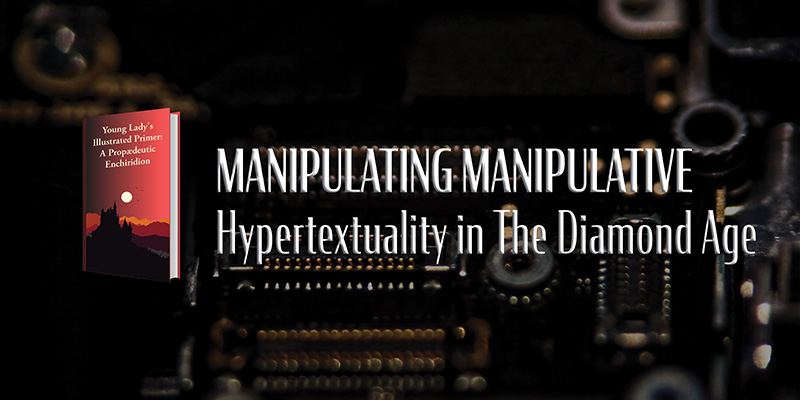Full Title: Manipulating Manipulative: Hypertextuality in Stephenson’s The Diamond Age: or, A Young Lady’s Illustrated Primer
Conference: International Conference on the Fantastic in the Arts (ICFA)
Location: Orlando, FL
First Presented: March 18, 2011
Original Abstract
Neal Stephenson’s The Diamond Age: or, A Young Lady’s Illustrated Primer is a future vision of Earth swarming in an ether of nanotechnology that is simultaneously reimagining the past and examining the conservative present. Neo-Victorian in design, the novel creates a fragmented utopian/dystopian future where microscopic aerostats, and humans through them, can manipulate the world at will. As a Dickensian tribute in many ways, both literally and figuratively, the novel skirts a Vingean Singularity while focusing on a little impoverished girl on the margins. This Little Nell becomes a stabilizing and subversive force with the help of a unique, and arguably fetishized, artifact: A Young Lady’s Illustrated Primer.
This text within a text can be seen both as manipulating and manipulated by the world that surrounds it, including Nell. While often discussed in passing, the Young Lady’s Illustrated Primer appears critically neglected, especially in regards to what it is: a highly interactive and networked hypertext. Many critics discuss the Primer only in regard to its shared heritage with cybernetic constructions of virtual reality. Steven Jones, for instance, considers the text only as part of his investigation of the late age of print and, more specifically, video game hypernarratives. Others, such as Marie-Laure Ryan, seem to discuss the Primer only as part of a discursive interlude focused more on its creator John Percival Hackworth.
The degree to which the Primer functions as a deus ex machina, both for Nell and for the constructed narrative world, is what I wish to analyze. The paper will leverage the work of N. Katherine Hayles, and her concept of the posthuman, to analyze Nell and expand on what Brooks Landon considers to be Stephenson’s futuristic expression of Ezra Pound’s concept of New Paideuma. Beginning with a brief examination of what the Primer is, and its relation to the concepts laid down by K. Eric Drexler and Kevin Kelly, the paper will then move on to examining how this pedagogical Turing Machine influences Nell’s development and its role as a creator/sustainer of her identity. Finally, the paper will return to the Young Lady’s Illustrated Primer and examine it as the epitome of a hypertextual construct networked to the world in which it exists and the narrative text.
Addendum
Unlike the FWPCA, the ICFA requires a longer 300-500 word abstract and a starting bibliography when submitting conference proposals. I found the requirement extremely useful since it helped me to fully consider my topic and the resources available before I wrote the paper rather than during. A little planning goes a long way and, in my humble opinion, this paper is better for it.
While this paper and the prior one consider the same subject, Neal Stephenson’s The Diamond Age: or, A Young Lady’s Illustrated Primer, the topics in focus are quite different. The first examined Stephenson’s usage of the fairy tale within the work and this later paper focuses strictly on the technological aspects of A Young Lady’s Illustrated Primer.
The Diamond Age was originally published in 1995, long before the iPad or the PC tablet became a material reality. Steve Jobs didn’t return to Apple for another two years, the Palm Pilot didn’t exist until 1997, AOL 4.0 with its new emoticons (emoji) did not ship until 1998, and the iPhone was not released until 2007—coincidentally the same year e-ink was first used commercially in the Amazon Kindle. Today, children use iPads and Chromebooks to learn to read and write much like Little Nell does in a book written over 25 years ago.
The Primer is an impressive educational tool and Stephenson uses it to explore the influence of technology on learning and learning on future material success. In a darker vein, the novel also explores how the influence of those creating technology can influence its use and outcomes. Nell was destined to live and die in abject poverty, but she eventually becomes the leader of a phyle. The Primer is the primary reason for Nell’s change of fate, so I felt it was worthy of closer examination than it had been given at the time.
While not everything I wished to cover in the abstract made it into the final paper, I did accomplish what I set out to do at the time.
